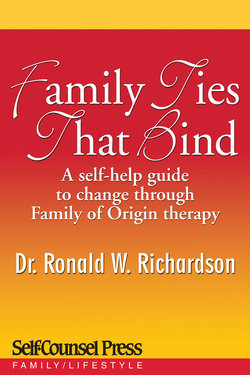Читать книгу Family Ties That Bind - Dr Ronald W. Richardson - Страница 10
На сайте Литреса книга снята с продажи.
3. All The World Wants A Mommy
ОглавлениеThe need for togetherness originates, like everything else, in the family of origin. Somewhere around the ages of six to nine, we begin to realize we are not going to get all the love and acceptance and security we want from our parents. As we get older, we slowly begin to develop a fantasy, which tends to peak in later adolescence, that somewhere out there is an ideal mate who will fill the emptiness we feel. We look forward to a time when we will be “in love” and experience true togetherness. What we didn’t get from our parents, we imagine we will get from our mate.
A major hidden expectation is that this person will provide for us the long-awaited bliss of perfect union. The more starry-eyed among us think this person is “everything I ever wanted in a mate.” The rest of us just think we will be able to turn that person into everything we ever wanted.
Example
Judith’s father had been hospitalized several times with emotional problems. Her mother was a highly anxious person and had little ability to nurture others. As the eldest of three, Judith basically ran the family and kept things going. She dreamed of the day when she would escape and live a more normal life.
After the failure of her second marriage, she sought therapy, wanting to find out what was going wrong. In spite of being an attractive and capable woman, her adult life was turning out much differently from what she wanted.
She discovered during therapy that she had been expecting her husband to give her the good feelings about herself that she never got from her parents. She had been the emotional pursuer, but since she had never really experienced closeness, she was, in fact, uncomfortable with it when it was available. She had chosen men who were basically at the same comfort level of closeness/distance as her family. They were unable to provide what she both wanted and feared. When she dated men who could give it to her, she distanced and did not continue the relationship.
The more children are deprived of nurture and guidance in early years, the stronger their fantasy later that this special person will make everything better. They fall in love with the image of what they think this mate will provide. When the reality strikes, they feel angry, frustrated, hurt, and disappointed. Then they usually try to figure out how to get what they want from the other person.
People usually find fault in someone when they’re not getting what they think they need. If they blame themselves, they try to find out what the other wants and then act on that to win approval or love. They give to get.
If they decide the fault is with the other person, they try various methods of changing that person. These methods may include everything from flattery to criticism to physical attack.
Example
Lela, the oldest of three sisters, had a chaotic childhood involving many moves and times when she lived with relatives rather than her parents. Her parents fought a great deal, and Lela resolved that when she married she was going to have a stable, happy family. She developed the skills and techniques she thought would help make this happen. However, she married Hank, an emotionally remote only child, who did not share her ideas about family. He was basically a loner and did not have much interest in parenting or in family life. He just wanted someone who would look after and admire him. What they wanted from each other was in strong conflict. Each handled the conflict the way conflict had been dealt with in their family of origin. Lela began to sound more and more like the “bitchy” mother she had hated, and Hank was increasingly like his distant father who had many affairs and stayed away from home. They moved a lot and fought a lot. Jani, their 19-year-old daughter, started saying exactly what Lela had said at that age: She wanted a “stable, happy home life.” Yet she behaved with her boyfriends the way her mother behaved with her father.
Both Lela and Hank had developed expectations about how their marriage should be, based primarily on their unfulfilled childhood needs. They got married thinking the other would automatically provide what they wanted; indeed, they insisted and demanded that the other provide it. They blamed each other and demanded that the other change. In fact, neither one was comfortable with closeness, and daughter Jani was the same way.
Too much togetherness can be as threatening in a relationship as too much separateness. It is not uncommon for couples to fight after they have had a particularly good and intense lovemaking experience or some other kind of intimate closeness. This happens because they fear that by becoming too close they will lose their own identity or become too vulnerable. Many people have the misconception that to be close means having to give up their individuality. That can be just as scary as having too much distance in a relationship. The challenge is to learn how to be close, open, and accepting, and still be a unique and separate individual. It can be done, as you will see.
